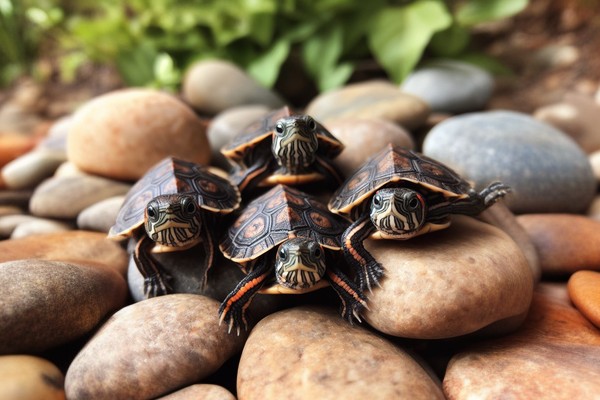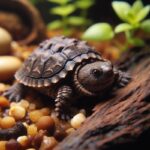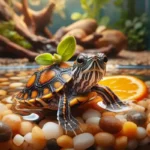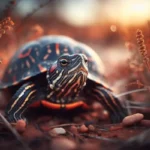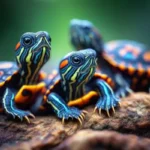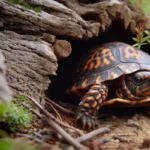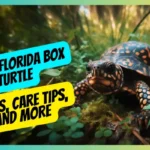Keeping pet turtles isn’t always easy but with some research any newcomer can become sucessful quickly!
Our Baby Red Eared Slider Care Tips contain plenty of resources dedicated towards helping new owners have longer healthier reptilian companionship experiences ahead so that both parties involved get maximum benefit out if it!.
So don’t miss out on anything important – dive right into it now!
Understanding the Baby Red Eared Slider’s Natural Habitat
Before diving into the specifics of baby red eared slider care, it’s important to understand their natural habitat.




These turtles are native to the southeastern United States and can be found in various freshwater environments, such as
- Ponds
- Lakes
- Slow-Moving Rivers
By mimicking their natural surroundings, you’ll create a comfortable and stress-free environment for your new pet.
Setting Up the Perfect Habitat
Creating the ideal habitat for your baby red eared slider is crucial to their overall health and well-being. To begin, here’s what you’ll require:
Aquarium or Tank
- Choose a tank that’s at least 20 gallons for a single baby red eared slider, with an additional 10 gallons for each additional turtle.
- As your turtle grows, you’ll need to upgrade to a larger tank. Adult red eared sliders require a minimum of 75 gallons.
Substrate
- Opt for a soft, non-abrasive substrate, such as river rocks or large gravel.
- Avoid using sand or small pebbles, as these can be accidentally ingested and cause digestive issues.
Basking Area
- Provide a dry, elevated area for your turtle to bask in, such as a large rock or a floating platform.
- Ensure the basking area is easily accessible and can support the weight of your growing turtle.
Heating and Lighting
- Maintain a water temperature of 75-80°F (24-27°C) using an aquarium heater.
- Provide a basking spot with a temperature of 85-90°F (29-32°C) using a heat lamp.
- Use a UVB light to promote proper shell growth and prevent metabolic bone disease.
Filtration and Water Quality
- Invest in a high-quality filter to maintain clean and clear water.
- Perform regular water changes to prevent the buildup of harmful bacteria and waste.
Feeding Your Baby Red Eared Slider
A well-balanced diet is crucial for the health and growth of your baby red eared slider. Include the following in their diet:
Commercial Pellets
- Choose a high-quality, nutritionally complete turtle pellet as the base of their diet.
- Feed your baby red eared slider a small amount of pellets daily, roughly the size of their head.
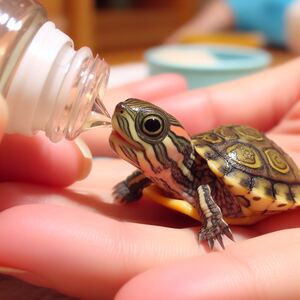
Protein Sources
- Offer a variety of protein sources, such as live or frozen fish, shrimp, and insects.
- Limit high-fat foods like feeder goldfish and earthworms to occasional treats.

Vegetables and Greens
- Gradually introduce leafy greens and vegetables, such as kale, collard greens, and dandelion leaves.
- Steer clear of iceberg lettuce, as it offers minimal nutritional benefits.
Vegetables and Greens
- Gradually introduce leafy greens and vegetables, such as kale, collard greens, and dandelion leaves.
- Steer clear of iceberg lettuce, as it offers minimal nutritional benefits.
Calcium Supplements
- Supplement your turtle’s diet with calcium powder or a cuttlebone to promote healthy shell growth.
Handling and Socialization
While baby red eared sliders may not be as cuddly as other pets, proper handling and socialization are still essential for their well-being.
Handling Techniques
- Approach your turtle slowly and gently to avoid causing stress.
- Support their entire body when lifting them, with one hand under the shell and the other on top.
Socialization Tips
- Limit handling during the first few weeks to allow your turtle to acclimate to their new environment.
- Gradually increase handling time as your turtle becomes more comfortable with you.
Health and Preventative Care
Regular health checks and preventative care are vital to ensuring your baby red eared slider thrives.
Signs of Illness
- Monitor for signs of illness, such as lethargy, loss of appetite, and shell abnormalities.
- If you observe any worrisome signs, seek advice from a reptile veterinarian.
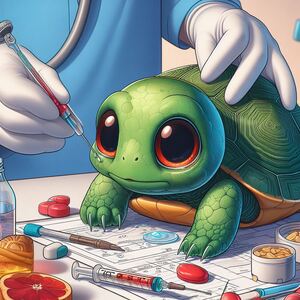
Preventative Care
- Schedule annual check-ups with a reptile veterinarian.
- Maintain a clean and well-maintained habitat to prevent the spread of disease.
What do baby red eared slider turtles eat?
Baby red eared sliders have a varied diet that includes:
- Commercial turtle pellets as a staple food
- Protein sources like live or frozen fish, shrimp, and insects
- Leafy greens and vegetables such as kale, collard greens, and dandelion leaves
- Calcium supplements like calcium powder or cuttlebone
What to feed a baby red eared slider
To ensure a balanced diet for your baby red eared slider, follow these guidelines:
- Feed them a small amount of high-quality turtle pellets daily
- Offer a variety of protein sources several times a week
- As they grow, slowly incorporate leafy greens and vegetables into their diet
- Supplement their diet with calcium for healthy shell growth
How to take care of a red eared slider baby turtle
Proper care for a baby red eared slider involves:
- Setting up a suitable habitat with appropriate heating, lighting, and filtration
- Offering a diverse range of foods for a balanced and nutritious diet
- Handling your turtle gently and gradually increasing socialization
- Monitoring their health and seeking veterinary care when needed
How long can a baby red eared slider go without food?
While adult red eared sliders can go without food for several weeks, baby red eared sliders have higher nutritional needs due to their rapid growth.
It’s best not to let them go without food for more than a day or two. Consistently provide a balanced diet to ensure proper growth and development.
Why is my baby red eared slider not eating?
There could be several reasons why your baby red eared slider is not eating:
- Stress: Newly acquired turtles may need time to adjust to their new environment. Give them a few days to acclimate before worrying about their appetite.
- Water temperature: Ensure the water temperature is between 75-80°F (24-27°C). Low temperatures can cause a decrease in appetite.
- Illness: Loss of appetite can be a sign of illness. Monitor your turtle for any other symptoms and consult a reptile veterinarian if needed.
- Food preference: Some turtles may be picky eaters. Try offering different food options to entice them to eat.
Additional Tips for Baby Red Eared Slider Care
To further enhance your baby red eared slider’s well-being, consider these additional tips:
Provide Enrichment
- Add hiding spots and decorations to their habitat to stimulate exploration and provide a sense of security.
- Rotate toys and decorations periodically to maintain their interest.
Monitor Growth and Development
- Keep track of your turtle’s growth and development to ensure they are progressing at a healthy rate.
- Adjust their diet and habitat as needed to accommodate their changing needs.
Educate Yourself
- Continually research and learn about red eared slider care to stay up-to-date on best practices.
- Connect with other turtle owners and experts through forums, social media, and local reptile clubs.
Conclusion
Baby Red Eared Sliders require a lot of attention and care if you are to provide your pet with the best life possible.
An experienced owner will know what supplies, food, environment and temperature requirements they need for optimal health and comfort – so be sure to do plenty of research before beginning turtle ownership!
Remember to monitor their growth and development, provide enrichment, and continually educate yourself to ensure your baby red eared slider thrives in your care.
So, why not start today and embark on this exciting journey with your new scaly friend?
